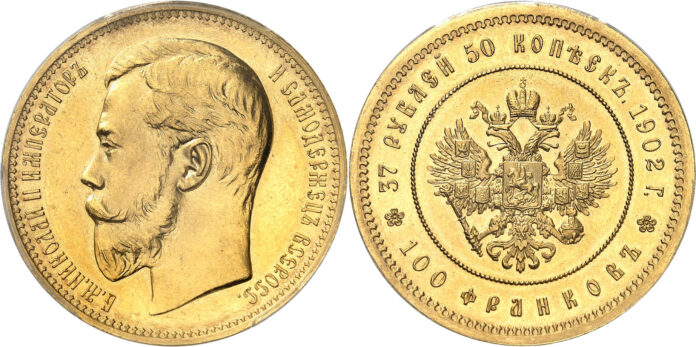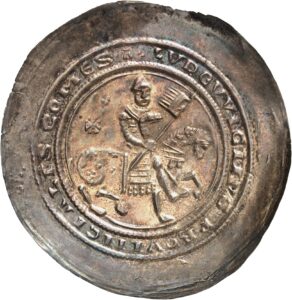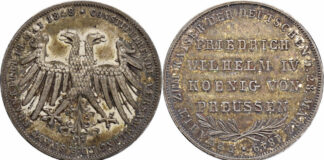A Feast by Collectors for Collectors
Künker’s Spring Auction Sales from 16 to 20 March 2020 prove once more that collectors approach Künker if they want to return a collection that they cherished for years to the cycle of coin trade. It is very rare to see so many special collections at once as it is the case during this auction week.
An outstanding highlight is obviously the Samel Collection of Jewish coins. However, there are also two impressive collections of medieval coins bearing witness to the profound knowledge of their creators – one of them focuses on north and central Germany, the other one on the area of Lake Constance.
Regarding ancient coins, collectors will find the 4th part of the Dr W. R. Collection, parts of the Phoibos Collection, of the collection of a North German friend of ancient coins and of the collection of a Hanseatic connoisseur of Roman coins, not to forget the pieces from a private collector from the Lower Rhine. Catalogue 335 contains the Dr Karl Walter Bach Collection of coins of new princes and the siege coins of the Eberhard Link Collection. In addition, there are comprehensive special collections focusing on Bavaria, Lübeck and Württemberg. Auction 336 ends with a very interesting series of patterns of German coins.
Seize the opportunity to find the exact right piece for your own special collection. Künker’s Spring Auction Sales will provide you with enough material to do so.
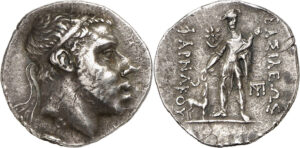
Auction 333: Coins From the Ancient World
Once more, the auction week starts with another part of the Dr W. R. Special Collection, this time, the numismatic journey leads us to Asia Minor and Cyprus. Whether it be Pharnaces I or Tissaphernes, Homer or Sappho, panthers, dolphins or bees – the entire imagery of the Greek coinage of Asia Minor prior to Roman times comes to life on these coins.

A few Celtic coins are followed by about 220 lots of Greek pieces, including an impressive series of Macedonian tetradrachms and staters, among others from Akanthos, Mende, Olynthus, Sermylia and the Orreskioi. Several Greek coins belong to collections of which parts were already sold in previous auctions, namely the Phoibos Collection and the collection of a north German friend of ancient coins.

Those who are interested in Roman portraiture but do not have the means to collect perfect aurei will be amazed by the collection of a Hanseatic connoisseur of Roman coins. With excellent knowledge and taste, he collected denarii, antoniniani and bronze coins featuring splendid portraits for decades. His collection is complemented by pieces of a private collector from the Lower Rhine area focusing on interesting coins of the Roman provinces. The estimates are very attractive; therefore, it is very likely that only very few pieces will be sold at the starting price.
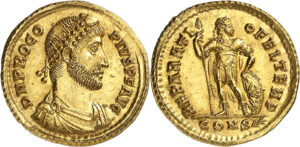
Of course, there is a wide selection for collectors of Roman gold coins, too. An extremely rare solidus of Procopius of excellent provenance is especially spectacular. The piece is from the Jameson and the ESR Collection.
Auction 333 ends with Byzantine and oriental pieces as well as Crusader coins.
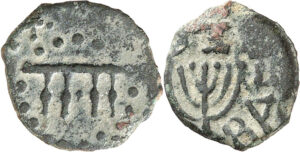
Auction 334: The Samel Collection: Jewish Coins and Medals
The Samel Collection of Jewish coins and medals featured in auction 334 is the highlight of the Künker auction week. The catalogue written by Johannes Nollé is a monument to one of the most important collections of Jewish coins and medals ever brought together. It covers the history of the Jewish people from the Persian conquest of Judea in the 6th century BC to our times, with the collection’s focal point being on ancient times.
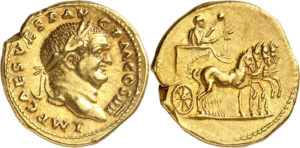
The collection does not only comprise Jewish but also Roman coins that celebrate victories over the Jewish people. Among them is a wealth of historically extremely significant pieces that may serve as material evidence to the literary reports written by Flavius Josephus.
Furthermore, the auction contains spectacular medals, which remind us, on the one hand, of the prejudices against Jews and, on the other hand, of the attempts of the 19th century to integrate the Jewish people as citizens with equal rights.
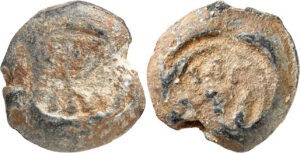
It ends with a series of gems, seals, weights and other objects that demonstrate that there had been Jewish life in the region of Palestine long before the first coins of Judea were minted.
Auction 335: Coins and Medals From Medieval and Modern Times
On 18 and 19 March 2020, Künker will hold the third auction of its Spring Auction Sales. It starts at least as spectacular as the second auction ended. However, now a different period is at the centre of attention. Those who are interested in medieval Germany will find a wealth of extremely rare material of outstanding quality and great art historical importance.
The first of the two collections comprises 250 lots and belonged to a passionate numismatist. The collection reflects the great expertise of the man who built it: it contains great rarities, but also many most beautiful pieces of a certain coin type. As an example, we want to mention the probably most beautiful known specimen of the splendid rider bracteate of Louis III of Thuringia. And the unique imperial bracteate from Eschwege – a historic testimony to the emperor’s visit of the “Boyneburg” in 1188, during which he settled a dispute between the Vogt and the abbess about the privilege of minting coins.
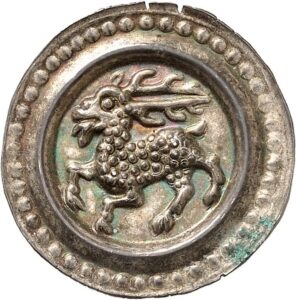
Additionally, 50 lots of medieval bracteates from Upper Swabia and from the region of Lake Constance will be on sale. Among these, too, there are numerous extremely rare pieces of outstanding quality.
Thus, every collector of medieval rarities should save the morning of 18 March 2020 in his agenda!
Coins and Medals From the German States: The Special Collections Bavaria, Lübeck and Württemberg
The section of coins and medals from the German States comprises as much as three special collections: Bavaria, Lübeck and Württemberg.

The Collection of Bavarian coins and medals contains about 330 lots and covers the time frame from the Middle Ages to the 20th century. The focal point is on early modern times and the period is represented by numerous talers. However, there are many pieces from the 19th century, too, including an extensive series of the popular commemorative coins of Ludwig I, most of them of outstanding quality.
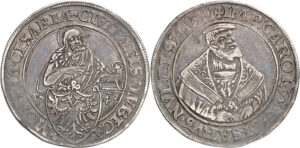
The special collection Lübeck comprises ca. 110 lots with coins and medals of the city and the bishops as well as a series of medals of the mayor. It covers the time frame from the 16th to the 18th century. The coinage of Lübeck is famous for all the beautiful city views; but there are also these splendid schautalers depicting biblical scenes like the Marriage at Cana and the Baptism of Jesus in the Jordan River.
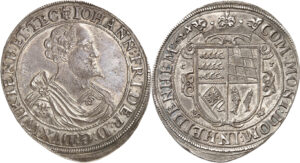
The third special collection on sale in the section of coins from the German States is dedicated to Württemberg. The time frame covers the period from the first Württemberg talers struck in 1507 to the coins of the Kingdom of Württemberg of the 19th century. Special collectors can look forward to very rare talers and splendid medals among the 150 lots.
Of course, a wealth of interesting individual pieces from the German States will be on sale in addition to these three special collections. You see, browsing through the material is worth it for everyone.

Coins of the Holy Roman Empire and the Bach Collection: Coins of New Princes
The section German States is followed by coins of the Holy Roman Empire including numerous rarities. The highlight of this section is the Dr Karl Walter Bach Collection with coins of the new princes from Austria. The coins of these families – which had originally been of rather low nobility, middle-class or from another country and which had been raised to the princely state by the emperor as a reward for the services one of their representatives had rendered to the dynasty – are in most cases extremely rare because they were not intended to enter circulation but to show status. They bear numismatic testimony to the fact that the society of early modern times was willing to let innovative minds climb the social ladder as long as they knew how the political power game worked.

Siege Coins – Another Part of the Link Collection
In auction 335, another part of the Link Collection will be on sale. This time, siege coins are on offer – a kind of emergency money issued to guarantee the circulation of official money within a besieged town. The about 300 lots are split up within the catalogue according to the cities in which they circulated. Whether it be the Siege of Breisach or Landau, Rákóczi’s War of Independence, or all the issues minted during the Eighty Years’ War between Spain and the Netherlands: the Link Collection provides a good overview of this historically interesting topic of collecting.
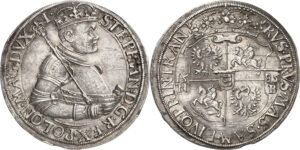

World Coins
Of course, this auction, too, offers a comprehensive series of world coins. Among them are not only several interesting individual pieces but also a large series of Russian coins.
Auction 336: World Gold Coins – German Coins After 1871
As if that wouldn’t be enough, on Friday, 20 March 2020, an auction of world gold coins and German coins after 1871 will be held. At this point, we will only mention the highlights of this auction:

In the section of foreign pieces you will find a gold medal of 15 ducats by P. H. Müller commemorating the defense of Corfu against the Turkish fleet in 1716 and a 37 1/2 rouble piece of Russian tsar Nicholas II of 1902, of which only 225 specimens were minted.
A quintuple ducat minted in 1629 for Ferdinand II in Wrocław is an example for the section of coins from the Holy Roman Empire.

The three most expensive pieces in the section German States are: a gold medal of the city of Emden of 4 ducats minted on the occasion of the 100th anniversary of the “college of forty” in 1689, a double gold gulden of Hesse-Kassel minted in 1677 of Eder River gold and a tenfold ducat from Regensburg of 1766 commemorating the homage to Emperor Joseph II.

The auction week ends with almost 1,200 lots of German coins minted after 1871. In addition to a wide-ranged choice of coins of the German Empire, the collection of patterns is especially worth mentioning. It contains some extremely rare trial pieces of silver coins of the German Empire, including a unique trial piece of Frederick the Wise and a unique trial piece of Saxe-Meiningen of 2 marks minted in 1900 D.
The catalogues can be ordered at Künker, Nobbenburger Straße 4a, 49076 Osnabrück; phone: +49 541 / 96 20 20; fax: +49 541 / 96 20 222; or via e-mail. You can also access the auction catalogues online.




